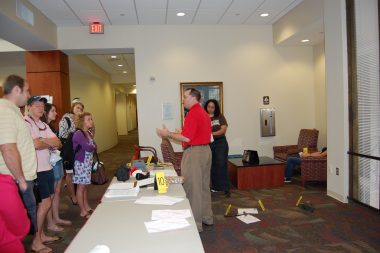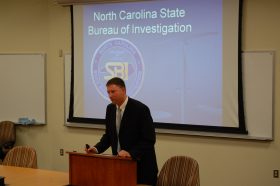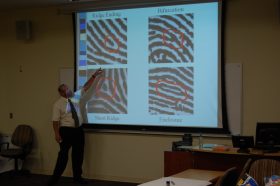On April 26, Elon Law professor Steve Friedland's criminal law course gave first-year students a chance to observe the legal ramifications of the processing of evidence during crime scene investigations. The special class, entitled “CSI Greensboro,” showcased experts in the fields of crime scene investigation, fingerprinting analysis and blood spatter.

During the crime scene presentation, students were led through a fake crime scene by Bryan Brendley, assistant professor of biology at Guilford College, reviewing steps necessary to maintain the integrity of the crime scene.
“It’s important to go in with no prejudice about what you think may or may not have happened at the crime scene. Many times what may appear to be a simple suicide can instead turn out to be a homicide,” Brendley said.
In addition to learning methods of crime scene investigation, students also received an overview of historical cases impacted by crime scene investigations.
“As a future prosecutor, I think it is important to understand how a crime scene moves through different levels, with each stage potentially impacting a case,” law student Marina Emory said. “Understanding the intricacy that goes into collecting evidence from a crime scene will make me a better advocate for victims of crime.”

Blood spatter expert Gerald Thomas of the North Carolina State Bureau of Investigation (SBI) led a presentation introducing students to a multitude of forensics evidence that can be found at a scene. Thomas discussed how a simple blood stain can tell investigators such things as the amount of force used, the type of instrument used in the murder, how many people were involved, as well as, how far the victim was from the assailant.
“The SBI presentation by Agent Thomas was fascinating,” said law student B.J. Williams. “It’s always interesting to hear real life experience about crime scenes and cases we have read about, day in and day out, for classes. It is clear that forensic science is an ever evolving area of law.”

Finally, students had the opportunity to learn about fingerprint analysis from expert Frank Keegan, a professor and director of the Forensics Institute of Guilford College. The presentation showcased the various methods of fingerprint detection, and Keegan explained to students how the analysis process works.
“It takes about two seconds after we lift prints for us to find a match in our database,” explained Keegan. “However, depending on how clear the prints are it could take up to two days for us to finalize the investigation and find a match.”
In addition to learning the methods of fingerprint analysis, students also had the opportunity lift their own latent fingerprints using grease from potato chips.
“I found the fingerprint analysis intriguing as it illustrated the various methods of fingerprint detection,” law student Katelyn Slaughter said. “It was also interesting to learn the classifications of fingerprint types and how impressions from two fingers are never identical.”
Friedland, who directs Elon Law’s Center for Engaged Learning, offers the CSI class each year in an effort to enhance student engagement in the study of criminal law and to provide practical experiences in observing criminal investigation procedures that often impact the outcome of legal proceedings at trial.
By Danielle Appelman, L’12


